Big World, Small Planet
Air Date: Week of March 18, 2016
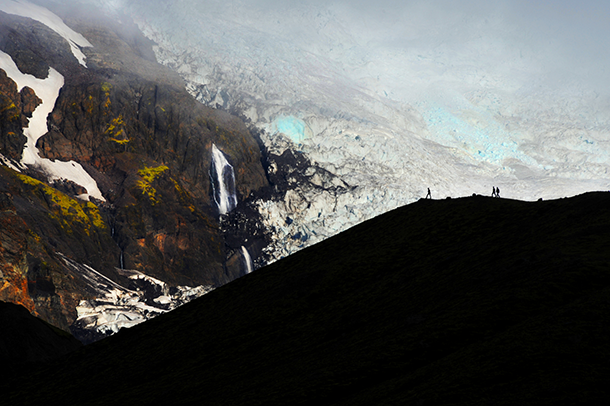
Against the impressive backdrop of a glacier in Iceland, three hikers appear as tiny silhouettes in the cover image of Big World, Small Planet. The book by Johan Rockström and photographer Mattias Klum takes the view that our growing human population can live sustainably on planet Earth, provided that we live within key planetary boundaries. (Photo: Mattias Klum)
From global warming to water shortages, humans are beginning to push up against a few fundamental planetary boundaries. Johan Rockström is a professor of environmental sciences at Stockholm University in Sweden and author of the book Big World Small Planet. He tells host Steve Curwood that humans can continue to grow and develop, as long as we respect key planetary limits.
Transcript
CURWOOD: It's Living on Earth, I'm Steve Curwood. More than seven billion humans live on Earth, but collectively we consume so many resources it would take more than one and a half Earths to sustainably supply them. According to Johan Rockström of the Stockholm Resilience Centre we’re rapidly pushing past Earth’s “planetary boundaries”. For example, how much fresh water and nitrogen and phosphorus we can safely use. Given these facts, his new book, a collaboration with photographer Mattias Klum called "Big World, Small Planet", asks us to think seriously about these planetary boundaries. Johan Rockström says the age humans have thrived in, the Holocene, has given us false sense of security, and he joins us now.
ROCKSTRÖM: Thank you.
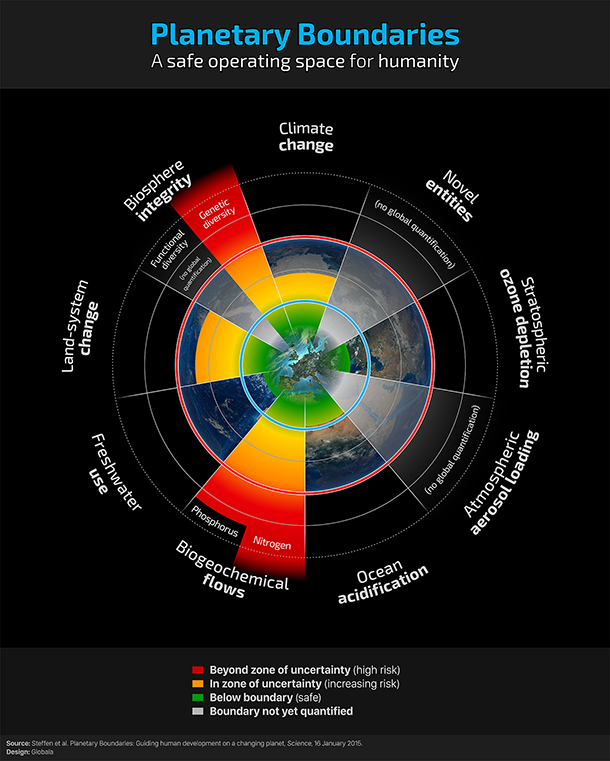
Rockström describes “planetary boundaries” that define the safe operating space in each of nine categories of Earth’s resources. (Photo: Azote Images/Stockholm Resilience Centre)
CURWOOD: Now, one of the strengths of your book, Johan, is that you've done some lot of really terrific math and integrated a bunch of scientific reports and understanding in a way that's really very accessible, but you have a number of concepts that I’d like to talk to you about and one of them is boundaries. What do you mean by boundaries?
ROCKSTRÖM: With the scientific evidence that we can define the desired state of the planet, the stable state of the planet that we need for our survival, the very, very, in a way, obvious scientific question is, “what are the environmental processes that regulates our ability to have a stable planet, and most importantly for each of these processes that regulates the planet, can we define a boundary within which we have a safe operating space?” So the planet has acted equivalent of when you're coming on a very, very meandering road on a mountain area, you have guardrails along that road that allows you to avoid the risk of falling over into an escarpment. So in the same way the planet has guardrails, what we call boundaries, that if you transgress them you risk reinforcing negative changes that could take you to a very, very dangerous situation, but as long as you stay inside, as long as you drive on the road safely within that boundary space, we can have all the opportunity for a thriving, prosperous future.
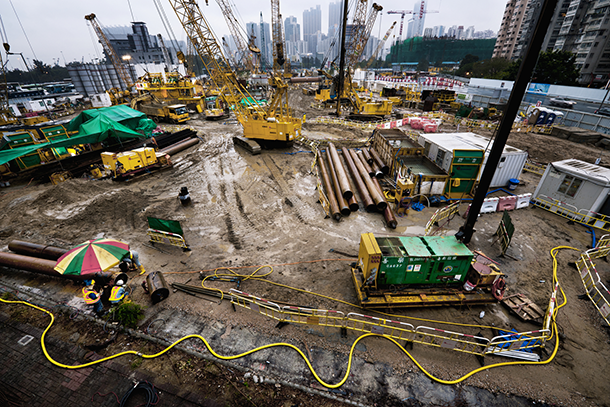
Construction projects like this one in Hong Kong are part of a boom in economic growth and population. Two thirds of the cities the world will need by 2030 have not yet been built. (Photo and caption: Mattias Klum)
CURWOOD: So, you list about nine boundaries in your book, but there are three you call “The Big Three,” and that really get us in a lot of trouble. Briefly what are those?
ROCKSTRÖM: Yes, so we have identified the nine global environmental processes that science shows clearly regulates the ability of the planet to stay in a stable, desired state. Among these nine there are three that have kind of come out as being the fundamental endgame of how all the planetary boundaries operate, and the number one is biodiversity, which is all the living species in what we call the biosphere and all the nature across the planet. We need forests, grasslands, wetlands, coral reefs, all our animals, all our plants, to have a good functioning planet. The second fundamental boundary is climate change. We need a stable climate system because the climate system determines the outcome for all the living species, you and I, animals and plants together. We recently got a very important progress in the global climate agreement in Paris saying that we need to stay within the safe operating space, within the boundary on climate change to one and a half degrees warming as a maximum allowed, as compared to the average temperature before the industrial revolution. And the third of the big three is what we call "novel entities". The totally man-made boundary. It has nothing to do with anything that the planet has ever experienced before, and it is our invention of chemicals, compounds, that are alien to nature like persistent organic pollutants or different kinds of nuclear waste elements that we concentrate in the biosphere and which are at risk of hitting us back through cocktails of chemicals that could, for example, abruptly and very unexpectedly change even the genetic code of different species, including homo sapiens - ourselves. So these are the kind of the three that science has identified as being absolutely critical.
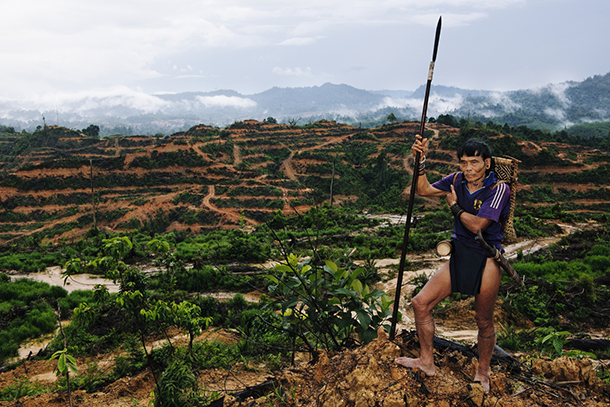
Tebaran, a hunter in Borneo, fears a difficult future for indigenous people as logging operations destroy the rainforest. Deforestation also impacts biodiversity and global climate. (Photo and caption: Mattias Klum)
CURWOOD: So, you're a scientist, Johan, but your book really raises important political and social questions, really, at the end of the day. At one point you note that one nation's unsustainable growth is another nation's threat to growth, and, as you've seen at the climate negotiations, the argument has been that the rich part of the world has conducted a lot of growth unsustainably and threatens the rest of the world. How do you untie this knot?
ROCKSTRÖM: Yeah, I know you're pointing at, if possible, the deep ethical challenge in the climate negotiations and what has been the explanation why the climate negotiations have been so complex over the years because, as you say, the rich minority in the world including countries like my own in Sweden and in the US have benefited from unsustainable use of energy creating huge exponential rise in wealth at the expense of the planet, and moreover we know that the outcome is so unfair because so far the bulk of those causing the problem are not the number one victims of impacts. Now, how are we opening up this? How to break this knot? And we're actually succeeding increasingly, thanks to one reason, which is overall we're finding so much evidence that even African nations, India, China is being more and more convinced about, which is that, why adopt coal-fired plants and oil, natural gas when solar photovoltaics and wind farms and smart biomass grids and electrification seems now to be cheaper and deliver better development simply bypassing the fossil fuel, period. So, in Paris, for example, what we saw for the first time is that all nations, rich and poor, committed very significantly to reducing emissions of greenhouse gases from fossil fuel burning. So that's one key reason, but I'd like to just emphasize that you're absolutely right that the moral imperative remains. The poorest countries in the world still say, you know, we need cheap energy and short-term cheap energy means coal and oil and we therefore need the right to go a bit slower when it comes to reducing our emissions and that is agreed and is even in the climate agreement which actually means - which we tend to forget - that your country, the US, and my country, in Sweden, needs to reduce emissions even faster to allow for a little slower transition in the most developing countries in the world. So that still remains, and that will certainly be a debate in both of our countries, I'm sure.

More than 75 percent of Borneo’s lowland rainforests have been cleared to make way for palm oil plantations. (Photo and caption: Mattias Klum)
CURWOOD: Indeed, and some folks in India are quick to point out that to keep things within the climate boundary that you described, the one and a half degree centigrade rise, there's room perhaps to release another 500 gigatons of carbon into the atmosphere. So, the fairness question comes. Right now the rich part of the world is equipped to keep emitting that carbon, and the poor part of the world really isn't, and that space will get gobbled up in the meantime before places like India, and the Indians have particularly made this argument. How do you regulate that so that in fact, in this last scramble to use the available ability to emit carbon, that there's at least a fair division of those rights?
ROCKSTRÖM: Well, to start with, you're pointing at what I think is perhaps one of the most dramatic and paradigm shifting implications of adopting planetary boundary thinking because, as soon as you accept that planet Earth has biophysical boundaries that we have to respect, that translates to absolute finite budgets that we need to share in a fair way. So, you know, the climate boundary, one and a half degrees Celsius, translates to a global carbon budget, roughly 500 gigatons, billion tons of carbon remaining to be emitted. We're emitting in the order of 30 every year, and that is the big issue that we face today, that if we recognize that we have 500 gigatons roughly remaining to emit, we have to then share this in the fair way, and we have to give China its part, India its part, Angola its part and so on and so forth. And what we find scientifically is that it therefore remains very little for countries like the US or Sweden or the UK or France, and we find that, for example, that we need to decarbonize – “we” meaning in the developed rich world - roughly by 2030, 2040, so 10, 20 years earlier than when the developing world needs to decarbonize. And 2030 is in 14 years, so were talking about an energy revolution, in fact, if we are going to stay true to the climate boundary of one and a half degrees Celsius.
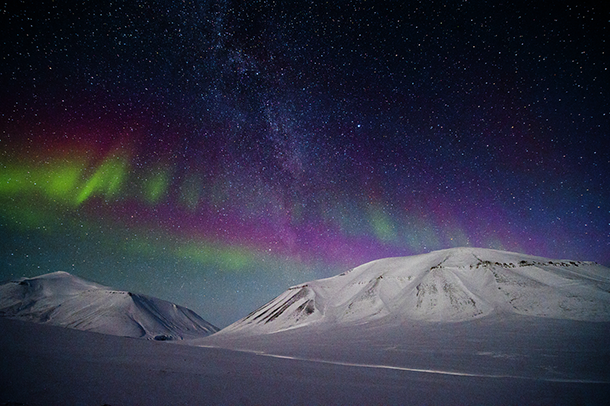
The aurora borealis plays across the sky over Svalbard, an Arctic archipelago. By reflecting sunlight back into space, the white surface of Arctic ice helps to cool the planet. (Photo and caption: Mattias Klum)
CURWOOD: Johan, talk to me about the planetary boundaries when it comes to feeding ourselves. Population is rising, and as you look at some of the limits, planetary limits, we’re already over the line from your perspective on things like phosphorus, the important fertilizer.
ROCKSTRÖM: Oh, that's right and this is such an important question, and the single largest threat to the stability on the planet and the single largest cause, even behind climate change, is agriculture in the world. Some 17 percent of the emission of greenhouse gases originates from how we produce food. The largest cause behind loss of biodiversity is because we're expanding agriculture into natural ecosystems. The largest consumer of freshwater by far is food. Can you believe it? Your and my diet just one day, if we have a little bit of meat on the table, will consume some 3,000 to 4,000 liters of freshwater for one person for one day. And finally there is no food to feed 7.2 billion people unless we use a tremendous amount of nitrogen, through nitrogen fertilizers and phosphorus. When we load too much nitrogen and phosphorus on our land, in our lakes, groundwater, and oceans, they get what we called eutrified, they get saturated with nutrients, and they come to a tipping point and abruptly go from clean water lakes to murky, dead systems that can no longer host living animals and plants. And what we're finding is that an absolutely key strategy to return within a safe operating space on Earth is to transform the world towards sustainable food production, and this challenge is, if anything, perhaps even the largest we face because we know that we're soon nine, ten billion people on Earth, and moreover we have one billion people going hungry every year. So if are serious about eradicating hunger in the world, and we’re serious about feeding a growing population, we will need roughly 50 percent more food production to be able to feed humanity. And our conclusion in the planet boundary analysis is that we can no longer expand agricultural land. We have to feed humanity on the existing land because we cannot lose more nature because nature is such an important habitat and host for biodiversity and sequesters carbon, et cetra, and moreover we need to drastically reduce our use of nitrogen. In fact, our scientific analysis shows we're in such a dangerous zone we have to reduce nitrogen use within the order of 75 percent of phosphorus. We're just at the ceiling of what we can use. We cannot increase that out even further. So this is truly an agenda for a new green revolution, what we called a doubly green revolution. Has to be sustainable, and it has to deliver food for humanity.
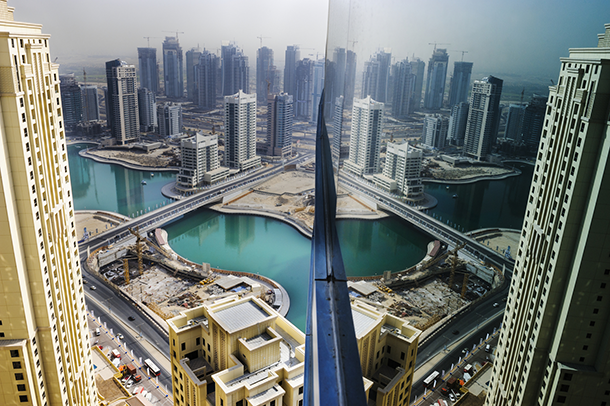
Dubai City, in the United Arab Emirates, reflects the challenges of sustainable urban development -- key to dealing with squeezes from population growth and affluence. (Photo and caption: Mattias Klum)
CURWOOD: So how do we do this? I know it's not fair to ask you. You're the scientist, you've come up with the numbers, the measures, the metrics. But how do you solve this political and social problem that, well, is existential for our civilization.
ROCKSTRÖM: Yeah, it's such a large question, and as you say, I thereby often can say, well, you know I'm an actual scientist and you're going to beyond my responsibilities as an academic. But we need to collectively have a red thread of universal value of us reconnecting with nature and basically become stewards of the remaining beauty on Earth. Now, you will tell me that, “Oh, but all this is naïve and utopia,” and I will answer, “Not necessarily, but it will take a long time before everyone would agree to that universal value.” So in the book we also say we need a fast track because the situation is urgent, and what is that fast track? The fast track is to strengthen global governance to have global rules that are enforced upon all the 200 nations in the world, to show clear signals to corporations, to communities, to mayors and cities to make sure that we are decarbonizing and therefore that is the technological path we're going for corporations. Yes, we are going to safeguard fresh water, so we need to produce food in this and this way. And the good news is, in fact, that last year political leadership actually took a step in that direction. The sustainable development goals adopted by the United Nations is, in fact, adopting a new framework with 17 goals for humanity to say, “Yes, we will eradicate hunger. Yes, we will have poverty alleviation. Yes, we will have good economic development within planetary boundaries.” And the climate agreement was actually setting a very, very, very ambitious step forward towards planetary boundary thinking. So we're starting to see what I think is needed on the short term, which is global enforcement, which is not making life painful for you or me. It's giving boundaries within which we can be successful. So, it's not about, they're saying, “Oh my God, now they're putting this environmental lid on my life and I have to back off and have a worse future. On the contrary, we know that an unsustainable future will give us so many invoices from the Earth system, from the planet, that it makes life more miserable and more difficult. Being sustainable can give us a better life and these boundaries can be regulatory measures from above to steer that.
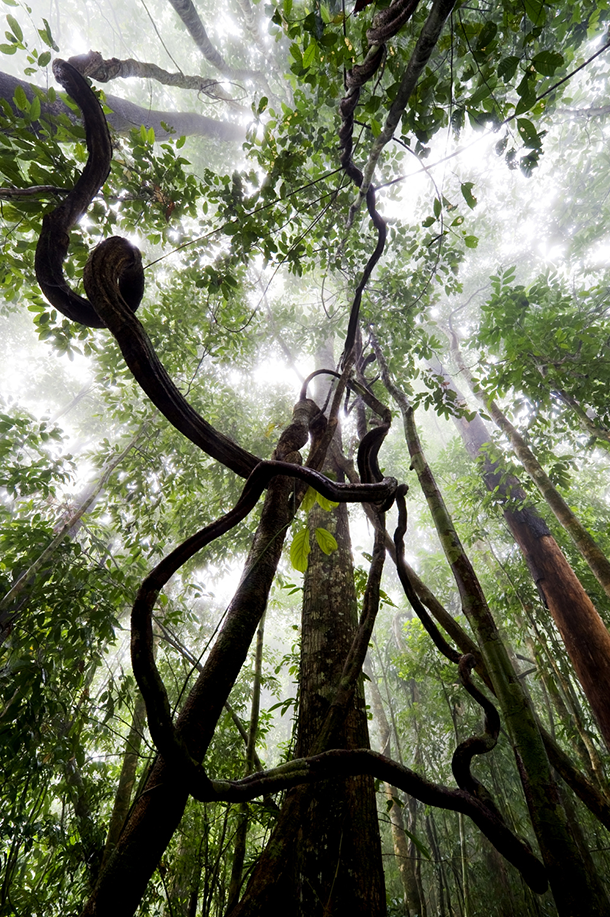
Lianas twine around dipterocarp trees in Malaysia’s Danum Valley Conservation Area. Rainforests provide a vast number of ecosystem services for humanity. (Photo and caption: Mattias Klum)
CURWOOD: So you call this approach, instead of “limits to growth,” “growth within limits,” but some would say you're talking about having world government here.
ROCKSTRÖM: Yes, and if I may or would say that's the wrong interpretation. So definitely we need all of us as a global community to agree on universal rules that apply at the planetary scale. We talk about becoming planetary stewards, we now need to basically govern and set the rules for human behavior on Earth. Now is that a world government? No, it's not. It is, on the short-term, something as simple, still challenging, but still simple of strengthening the United Nations. Why couldn't we in the Security Council in the United Nations take as serious discussions on climate change as we do on ISIS, on biodiversity as we do on Iraq, on freshwater marine systems as we did on the big dilemma with Libya. So you know we would simply need to place up planetary sustainability, from climate to biodiversity, on an equal par with insecurity issues that we deal with so seriously with regards to -- which are very serious -- with regards to terror and war and different, you know, social disruptions, and we can deal with that through global governance. We need enforcement and steering, but that is not about blocking innovation and markets and liberal innovation development, it's rather setting the guardrails within which we can have a good, free, and independent development.
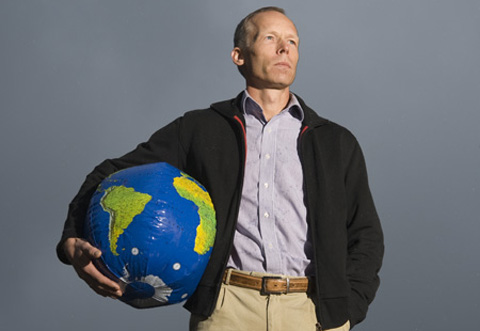
Johan Rockström is a Professor in Environmental Science with emphasis on water resources and global Sustainability at Stockholm University, and the Executive Director of Stockholm Resilience Centre. (Photo: courtesy of Johan Rockström)
CURWOOD: Johan Rockström is co-author of "Big World, Small Planet". Thanks so much for taking the time with us, Professor.
ROCKSTRÖM: Thank you, and a great honor to be on the show.
Links
Big World, Small Planet: Abundance within Planetary Boundaries
Living on Earth wants to hear from you!
Living on Earth
62 Calef Highway, Suite 212
Lee, NH 03861
Telephone: 617-287-4121
E-mail: comments@loe.org
Newsletter [Click here]
Donate to Living on Earth!
Living on Earth is an independent media program and relies entirely on contributions from listeners and institutions supporting public service. Please donate now to preserve an independent environmental voice.
NewsletterLiving on Earth offers a weekly delivery of the show's rundown to your mailbox. Sign up for our newsletter today!
 Sailors For The Sea: Be the change you want to sea.
Sailors For The Sea: Be the change you want to sea.
 The Grantham Foundation for the Protection of the Environment: Committed to protecting and improving the health of the global environment.
The Grantham Foundation for the Protection of the Environment: Committed to protecting and improving the health of the global environment.
 Contribute to Living on Earth and receive, as our gift to you, an archival print of one of Mark Seth Lender's extraordinary wildlife photographs. Follow the link to see Mark's current collection of photographs.
Contribute to Living on Earth and receive, as our gift to you, an archival print of one of Mark Seth Lender's extraordinary wildlife photographs. Follow the link to see Mark's current collection of photographs.
 Buy a signed copy of Mark Seth Lender's book Smeagull the Seagull & support Living on Earth
Buy a signed copy of Mark Seth Lender's book Smeagull the Seagull & support Living on Earth

